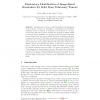Free Online Productivity Tools
i2Speak
i2Symbol
i2OCR
iTex2Img
iWeb2Print
iWeb2Shot
i2Type
iPdf2Split
iPdf2Merge
i2Bopomofo
i2Arabic
i2Style
i2Image
i2PDF
iLatex2Rtf
Sci2ools
MICCAI
2008
Springer
2008
Springer
Exploratory Identification of Image-Based Biomarkers for Solid Mass Pulmonary Tumors
If imaging is to serve as a valid biomarker in the assessment of the response of cancer to therapies, a reproducible and predictive radiologic metric is required. A biomarker is an indicator of a biological property that can be used to measure the progress of disease. While current size-based, quantitative techniques provide numerical representations of tumors, they are not necessarily indicative of disease progression for advanced cancers. In this paper, we present an end-to-end process to explore the use of other image-based features especially statistical textural features for cancer change detection. We exploit the earth mover's distance metric for measuring the change in the tumor burden over a period, between the time the baseline scans were taken, and the time the therapy response scans were taken. The time-to-progression (TTP) of the disease is our known patient outcome. We analyze the correlations between TTP and our change measurements and discover that the local texture...
Disease Progression | Medical Imaging | MICCAI 2008 | Predictive Radiologic Metric | Tumor Burden Size |
| Added | 06 Nov 2009 |
| Updated | 06 Nov 2009 |
| Type | Conference |
| Year | 2008 |
| Where | MICCAI |
| Authors | Ifeoma Nwogu, Jason J. Corso |
Comments (0)

